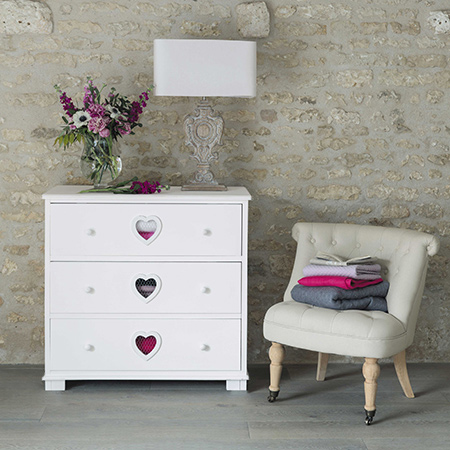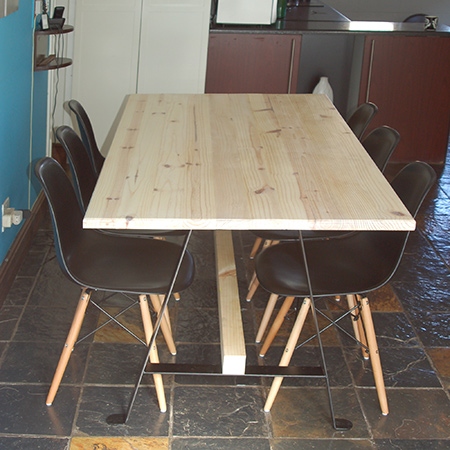When to DIY or Buy
I'm an avid DIY fanatic who loves to make decor accessories and furniture. But I don't make everything I own - I have come to know my limits and what I can and cannot make on my own. So when do you DIY or buy?
There is nothing more satisfying that making the perfect piece of furniture. Once you have acquired some basic skills, making your own furniture is a way to save money and add unique furniture to a home. Our Heart Dresser is a reasonably simple project - and one that cannot be bought, which makes it a great project for making your own.
One thing I can guarantee... making your own can save you lots of money and the satisfaction of a job well done is worth the effort. Having said that, you want to make furniture where your family and friends actually say, "Where did you buy that?" and not furniture where they ask, "Did you make that?" - there's a big difference between the two. Taking extra time to assemble and finish your projects professionally is the difference between an item looking made or bought. Something to bear in mind when you want to take shortcuts!
Think it through
Before you start any project you need to determine whether or not you have the skills to take it on and finish professionally. There are thousands of projects in the Internet, and we have hundreds of projects here on www.Home-Dzine.co.za. Since I do a lot of the projects myself, I tend to try and do ones that are reasonably simple and use tools that I already have. Before you start any project, look at the skill level and read through the instructions. In this way you will be able to decide whether or not it is something you can do.
Nowadays, we have access to a wide range of tools and materials that you will find at your local Builders Warehouse or Builders store. Where materials are not available locally, you will need to consider local substitutes. Consider the cost of materials to ensure that your particular project will not end up costing more than a bought item, unless you are using unique materials and the value of the finished project is worth the expense to you.
Some furniture projects, such as my Upholstered Storage Ottoman, are items that cannot be bought in a store, or at least bought for reasonable cost. These projects are well worthwhile if you research the most affordable materials and methods to make them.
Have the right tools
First and foremost, it is important to have a decent set of tools. Deciding what tools you need can be tricky, especially with the vast array of power tool options available today. I have previously discussed the tools I can't live without and you will find plenty of tool tips in our Tool Section. You can use these articles to select the methods that work best for you and then buy the right tools based on the type of furniture that you want to make and the tools needed.
The choice of tools is a personal decision; there are those who enjoy working with a Kreg Pocket Hole Jig and others that would rather use a Biscuit Joiner, and if you can't afford to splurge on tools like these you can always go back to basics and use older, alternative methods for joining pieces together. These tools just make life - and your projects - easier to do.
TOP TIP: For large projects where you don't already have the tools, factor in the cost of tools and, if you still come out saving quite a bit then the project is worth it.
My most recent undertaking was to make a dining table. The only reason behind this project was the fact that to buy a table, of far inferior quality, would have cost R6000 while making my own only cost R2000. That's a huge saving by anyone's standard and the finished design looks even better than that of the store-bought option.
Assess your skill level
When deciding to make your own furniture you need to consider whether or not you have the skills. Without the necessary skills taking on a project that ends up looking like a 'bought' piece and not a 'made' piece is not easy. We have seen plenty of attendees at our DIY Divas workshops that should be kept as far away from power tools as possible. We always recommend that you start with small projects and move on up to larger, more difficult projects as you gain the confidence and know-how.
Start small with projects that incorporate a variety of tools and techniques to gain confidence using power tools and understanding basic jointing and finishing methods. Make a stool or kiddies chair using basic power tools to get you started.
Finishing your projects
Finishing projects that have been assembled well ensures that any project looks good. It's not about slapping on a couple of coats of paint and hoping for the best. You have to be prepared to put in the time and effort to apply a professional finish. Get to know what products are available by walking the aisles at your local Builders or hardware store.
When making my own projects for placing on www.Home-Dzine.co.za, I try to ensure that materials are readily available. When placing projects by others, I try to offer alternative solutions. Know what is obtainable before you start, so that you have time to look at substitutes to achieve the finished look that you want. Visit our Decorating Section for advice on various methods and techniques for finishing.
Ask for advice
Don't be afraid to ask for advice if you are unsure about the correct way to proceed. Here on www.Home-Dzine.co.za we offer plenty of tips for successful DIY furniture projects as well as the easiest and strongest jointing methods. And you will find plenty more in our DIY Section.
Consider that we all have to start somewhere. It is only in the last 8 to 10 years that I have started making my own furniture. Yes, I had quite a bit of experience beforehand, but not using today's power tools, methods, materials and techniques. Practice does make perfect if you hone your skills over time. Have patience and you will soon realise that you can make your own furniture, if you take all the above into consideration.





